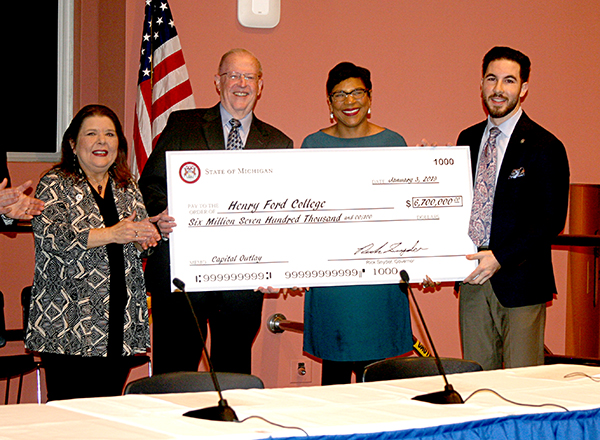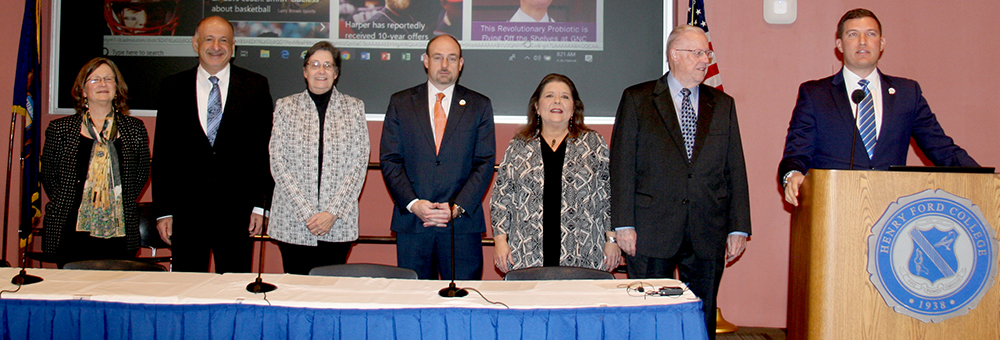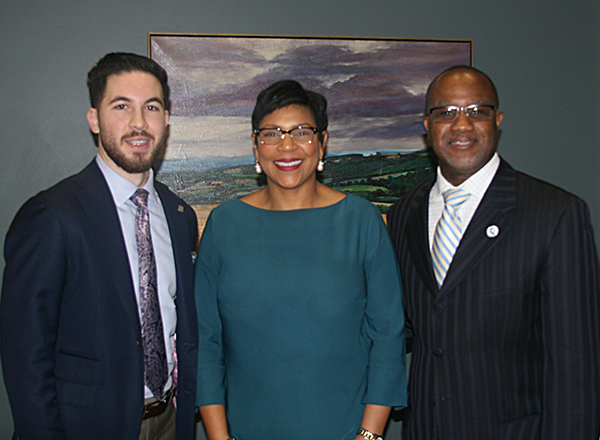January State of the College: points of pride, vision for 2019 and beyond

Photo: State Representative Abdullah Hammoud, right, and State Senator Sylvia Santana, second from right, present a large check to Board of Trustees Chair Michael Meade, Trustee Roxanne McDonald, and (outside photo frame) Trustee James Thorpe, Trustee Mary Petlichkoff, Trustee Hussein Berry, Trustee Mary Lane and (not pictured) Trustee Fadwa Hammoud.
President Russ Kavalhuna, the Board of Trustees, Vice President Reginald Best, and two state legislators kicked off the Winter 2019 semester at Henry Ford College with the exciting announcement that the College’s capital outlay request had been approved at the close of the 2018 legislative session.
Read more about the funding for the Entrepreneur and Innovation Institute here.
The Big Check
The announcement was followed by the presentation of an oversize check from Representative Abdullah Hammoud (D-Dearborn) and now-Senator Sylvia Santana (D-Detroit) representing the state’s $6.7 million contribution to the project. Representative David Knezek (D-Dearborn Heights) also played a significant role in advancing the capital outlay appropriation for the College.
“We will begin project planning with the development of an RFP for an architect, and we will submit plans to the State Building Authority. After their approval, we can begin construction,” said Kavalhuna. “It usually takes 18 months to three years for a project like this, so I expect to be back here in 2021 or 2022 for a ribbon-cutting" on the new facility.
The College will create a website with project updates, and will place a webcam in the vicinity once construction is underway, so the College and local community can follow the project’s progress.
The representatives who helped the project move forward shared their thoughts with the audience. “Four years ago, a seed was planted,” said Santana. “Now, the results of our hard work and dedication have flourished. We are pleased to deliver on our promises.”
“As you may know, capital outlay is not easy to appropriate,” she added. “Henry Ford College was one of three colleges to receive capital outlay in the supplemental budget. Small business development is very important to me – it anchors communities and provides job opportunities. So I’m pleased that this project will support those goals.”
Representative Hammoud noted that President Kavalhuna was in Lansing just one day after being appointed president of Henry Ford College, and his presence had an impact.
Hammoud also noted that the appropriation had personal meaning for him. “This College was the vehicle that pulled my family out of poverty,” he said. “My mother studied accounting, and this allowed her a pathway to a career. It gave my parents with the ability to provide their children with what is known as the American Dream. Now, for me to have a platform to fight back for a College that has given me and my family so much, and has given the Dearborn community so much.... I don’t know all the words to express gratitude for this. We are your voices in Lansing. Whatever we can do, consider us partners for a long relationship in the years to come.”
Board of Trustees Chair Michael Meade had congratulatory words for the College and the new president, who helped bring the appropriation to fruition. “The citizens of Michigan see us as having a major responsibility to educate the citizens in our communities,” he said. “To provide technical education, you need updated equipment and facilities. So this is a banner day for us.”
A litany of thanks is due to many individuals for the key roles they played over the past several years in realizing the capital outlay appropriation. Among them are Vice Presidents Michael Nealon, John Satkowski, Cynthia Glass, and Reginald Best; Dean Patricia Chatman; former President Stan Jensen; and the members of the HFC Board of Trustees.
Themes from the Listening Tour
Following the check presentation and remarks, Kavalhuna turned the conversation to the state of the College. He presented a recap of his Listening Tour. Some key themes he heard from faculty and staff during the past six months included:
The immense pride of people who work here, to serve the public good. He said there is a single line of impact – we do make a difference in society and the lives of individuals, which crosses all lines of staff, faculty, students, alumni, and our many partners in the community and beyond.
HFC employees want to have more than a job; they want a meaningful career. They want to be represented and understood, and they want to contribute.
There were a number of what he called “basic discrete concerns” about logistics like A/C, cleaning, small equipment, etc. Many of those issues have already resulted in improvements and cleanup.
There were many comments about the organization of Academic Affairs, and especially the ongoing efforts toward the reorganization of 2017. Academic Affairs, he said, is responsive to suggestions for tweaks and improvements, and faculty and staff should continue providing input.
We need to get better at understanding HFC students, particularly in relation to student matriculation and retention.
“The listening hasn’t concluded,” said Kavalhuna. “I will always listen to you, and I will respond thoughtfully, even where we do not agree. I will tell you if I can’t help. We should all do this for each other, at every level. We need to have open discussions. Are you hearing your colleagues? Remember, the best way to do many things is not to go through the president, but to engage your colleagues in collective solutions.”
Strategic enrollment management
He spoke next about the initiative toward Strategic Enrollment Management, which was the subject of a presidential message in late December. It is no secret that our enrollment has been declining, and turning that trend around will require concerted efforts, both in the short-term and the long-term.
Safety on campus
Safety on our campuses, and open conversations about the topic, was another theme. “It is time for a public discussion on the question of safety on our campuses," he said. "I have asked Vice President Glass to lead the way in learning from other Colleges and from our own community about how to get where we need to go. We probably will not all agree on everything. But we need to collect good information, and talk openly and clearly about strategies and solutions and outcomes.”
Higher Learning Commission and accreditation
This year marks a return visit from the Higher Learning Commission, the body that provides the College’s accreditation. “This is a zero-fail exercise,” he said. There is no room for failure, but accreditation also provides “an opportunity to learn about and improve ourselves.” More information about accreditation can be found on the College’s website, under Institutional Research, Planning, and Accreditation.
Strategic planning
“What shall we judge ourselves by in the next five years?” asked Kavalhuna.
The College’s current 5-year strategic plan runs through 2020, so it is time to create an updated plan this year. The process will be open, collaborative, and iterative, and we will be looking for involvement from all employees. The goal is to set our direction together, so we can accomplish our objectives and keep students at the forefront of everything we do.
Points of pride
It is important to keep our eyes to the future, but it’s also important to look back on the major accomplishments of the past year. Just a few of these accomplishments were among those Kavalhuna noted:
The successful capital outlay fund request.
The 70% voter support for the College’s millage continuation, which represents 5% of our budget.
The broad collaboration in the millage renewal effort, including the AFT, AFO, Local 71, the SSA, and everyone across the College, supporting the College’s needs.
The two consortia that included HFC, which received funding in December from Governor Snyder’s Marshall Plan for Talent initiative. One, in collaboration with UDM and the Melvindale schools, will support robotics and computer drafting. The other, in collaboration with Detroit Public Schools and Wayne County Community College, will support workforce development (See website story for more information).
HFC will participate in the national Degrees When Due project, which will help people who have some college credit, but no credential or degree, continue and successfully complete a career-focused educational path.
The College migrated all employees to Outlook for email and calendaring, and implemented the Office 365 collaboration suite for all employees.
We cut our bad debt in half this year.
We granted more than $400,000 in scholarships to more than 400 recipients.
IRPA has implemented Tableau, a software package that will allow HFC employees to make better use of a vast trove of data so we can make better, data-driven decisions.
Amy Clark and Caryne DeMatteo are now reviewing all contracts to make sure they comply with legal requirements and protect the College from liability.
Student Affairs has implemented broad training sessions for employees on critical issues relating to the student experience at HFC.
Passion: Why are we here?
Kavalhuna’s concluding remarks recalled the spirit of his request from August 2018: that each of us choose to work with our colleagues in a spirit of teamwork and collegiality.
“I gave you a sort of pep talk,” he said, “and asked you to let go of any past issues in favor of the common good. I urged you to give each other the benefit of the doubt, to talk to people rather than about them, and to be a good teammate.
“I’m seeing some of this take hold, and I hope you are too,” he added. “Please, continue to have these courageous conversations and ask how you can be even better as a colleague.”
Kavalhuna then noted that the next steps in this process will resemble an intellectual or athletic exercise that requires hard work and continued practice.
“The big question is: Why are you here?” he asked. “We have to find and focus on our sole mission. What is your passion? Our collective answer to this question will influence our strategies for enrollment and our activities in every area.
“Knowing your passion makes a difference in whether you are happy or not happy. This collective effort also helps defeat animosity and what I call our ‘natural nastiness’ -- which all of us are prone to from time to time. We have to invest in the College, and we have to invest in each other. We need to have one singular mission that will drive our success. Otherwise, we are just a collection of people working hard for disparate purposes, and we will never reach our highest standard of excellence.”
As President Kavalhuna noted in August: Nothing can hold us back but ourselves. The coming year will be about moving forward as a team, and defining the directions in which we will move together in service of our students and our community.

